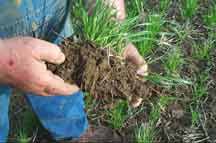I’ll never forget the first time I saw the results of large scale pivot irrigation from the air. The square miles of patchwork rectangular fields interrupted by amazingly green circles of green.
Cover crops have the potential to turn lots and lots, acres upon acres, into green. And I mean that in more ways than one. And among the most beneficial aspect of planting something like annual ryegrass? It doesn’t need to be irrigated. And, because of its deep rooting nature, irrigation of crops is required less, if at all.
Annual ryegrass roots grow to depths of four, five and even six feet under. The mass of roots, in addition to being a great source of food for microbiology in the soil and a way to increase your organic matter, actually create an environment in which available precipitation is more easily integrated into deeper soil structure. That means your crops will be better able to withstand dry and drought conditions.
With its deep rooting structure, annual ryegrass also “mines” nutrients from deeper soil layers, like P and K. And because annual ryegrass sequesters available nitrogen while alive, that nitrogen is available (through the decay of roots and residue) during the growth season for corn and beans in late spring, after terminating the cover crop.

The final “green” in the equation is profit. With annual ryegrass as a rotation partner, you’re not having to invest in irrigation equipment. You’re spending less on nitrogen and weed control. You’re not having to repair eroded fields or install miles of tile lines.
Then, you find out that your soil’s health is improving with cover crops. You learn that the organic matter is increasing again after a generation of deep tillage. You find that you can graze the cover crop and make extra money with livestock. Then you see that your corn production is increasing with fewer inputs! Your harvests are larger. Your bottom line is bigger.
So when you hear the liberals chanting about a “Green New Deal” you can smile and say “I’ve got my green new deal. It’s called annual ryegrass, and I’m happy as a clam.”




